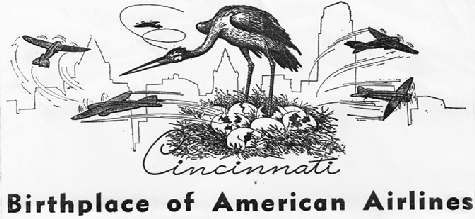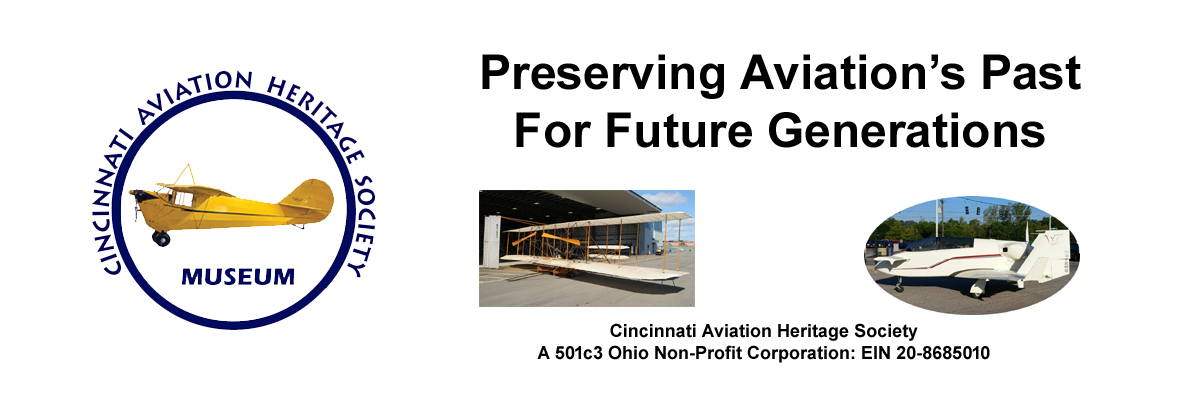Birthplace of AA

American Airlines
Cincinnati Times Star - Thursday April 25, 1940
By Herbert J. Lyall-District Sales Manager, American Airlines, Inc.
It is a far cry from the day in 1250 when Roger Bacon demonstrated the possibilities of flight by causing a large hollow globe, filled with gas, to rise from the ground to this day and age of huge airplanes and practical air transportation.
Many have contributed to our flying knowledge down through the centuries, and the sum total of their contributions has resulted in the most modern form of transportation. Leonardo DaVinci was an inventor as well as an artist and sculptor and first demonstrated the use of a parachute. He also strove to build a flying machine with wings like a bird, but it wa impractical. His efforts did show that men were trying to learn the secret of flying.
Balloons were the first successful aircraft. Joseph and Stephen Montgolfier made an ascension in France in 1783 in a balloon less than 100 feet in diameter. Hot air lifted the balloon and was the lifting agent. History tells us the Montgolfier ascension was the first flight of a man.
Others followed the lead of Montgolfier brothers and balloon ascensions became a popular spectacle throughout Europe. The first English balloon was flown in 1784. America was at the forefront with a balloon flight by James Wilcox in 1783.
Things kept up at a fast rate of speed in aviation. The army and navy collaborated in a flight around the world in 1924. An American dirigible, built in Germany, made a trans-Atlantic flight that same year. Admiral Richard Byrd made the first flight over the North Pole in 1926.
The year 1927 was a banner year for flying. Richard Byrd and Lindbergh flew the Atlantic, as di Chamberlain and Levine. The latter was the first trans-Atlantic passenger. The Pacific intrigued flyers that year and intrepid Lieutenants Maitland and Hagenberger flew from San Francisco to Honolulu. Many remarkable endurance flight records were set up.
Today interest in the manufacture of airplanes for private, commercial and military purposes is greater than it ever was before, and the United States is very fortunate in being a leader in commercial aviation. Our Government led the way in providing air mail service and is the leader in passenger air travel.
The first authentic passenger on an airplane was Charles Grant of Columbus, Ohio. Grant's father, Glenn M. Grant was manager of the enterprises of pioneer flyer, Glenn Curtiss.
Curtiss had been a motorcycle expert before entering aviation and held the world's record for speed. He flew one-man dirigible balloons before building his first airplane. It was Curtiss who installed an engine in Prof. Langley's "flying machine" and flew it to vindicate Langley.
Mechanics had been taken up prior to young Grant's flight on Oct. 12, 1910, at Cleveland, but no passengers. The Curtiss machine was made largely of bamboo and what was called aeroplane cloth. The pilot sat in front on the one seat available using foot pedals and a swinging wheel.
An early distance-flying record was made by Glenn Curtiss when he made the world's over-water flying record, flying from Euclid Beach to Cedar point, O., on Aug. 31, 1910, a distance of 72 miles each way.
In 1931 air passenger travel had grown to more than 500,000 passengers since 1926 when 5,782 passengers were carried. The million passenger mark for a year was passed in 1936 when all airlines travel was combined for the total and 1939 Americans alone flew 41,757 passengers for a total of 207,360,215 revenue passenger miles. The total for all airlines during 1939 was approximately 1,877,700.
Cincinnati entered the aviation picture at an early date and many great pioneer flyers appeared on barnstorming tours. Capt. Albert B. Wunder, who is today the superintendent of Airports of Cincinnati, was an early flyer and has been in charge of the Cincinnati port since its inception.
LAND FOR LUNKEN FIELD DONATED TO CITY
In the first days of Cincinnati flying the flights were made off what was called "Turkey Bottoms," site of the present modern airport. The Embry-Riddle Co. sold passenger rides. Riddle was the manager and practical flying man and Embry furnished the capital for the company.
In the fall of 1925, the Army Air Corps, which was still at Grisard Field, moved down to the present Lunken Airport. At the same time Watson took over Grisard Field and that became Watson Field. In the same year, Riddle and Embry teamed to form what was Cincinnati's first aviation corporation to amount to anything.
Capt. Wunder joined with them on March 1, 1926, and was the first paid employee of the company. The company functioned as Embry-Riddle until taken over by American Airlines, Inc., in the autumn of 1929. It had started to fly United States mail on Dec. 15, 1927, while still the Embry-Riddle Co.
The nucleus of Lunken Airport, 204 acres of ground, was presented to the City of Cincinnati by Edmund H. Lunken and his associates, who held stock in the original airport company. These holders of company stock comprised a group of philanthropic civic-minded citizens who did not form a group with any idea of personal gain, but were anxious to foster aviation commercially in Cincinnati.
The city upon receipt of the gift of 204 acres obligated itself to purchase the certain properties which extended from the original Lunken tract to Beechmont levee on the east and extended from the Pennsylvania Railroad embankment on the north to the Little Miami River on the south. This was done in 1928. The present airport with its runways, protective dikes and hangars, was planned then and contracts were let during that year. Construction was begun in the fall.
The total acreage of the Cincinnati Airport is now 1,125 plus, of which 450 are now developed for airport purposes, including 300 acres of actual landing area, and undeveloped portions temporarily used by the Cincinnati Recreation Commission, the municipal gardens, and other farm properties which at present are outside of the dike.
Runways and buildings at Lunken Airport were completed in 1930, although operations were carried on from a temporary administration building until the autumn of 1937. The airport now has approximately two and one half miles of concrete runways, which are 100 feet wide, and adequate landing area, so that it is considered one of the best airports in the country. It is the best drained landing field and has the finest turf in the land between the runways.
Passenger service now exists between all of the continents and flyig is an international factor in travel and commerce. It is steadily growing so that it is impossible to predict today what rapid strides will be made in the near future. Flying has made an advance in the last ten years that far exceeds the advance in any other form of transportation in five or ten times that length of time. The inventive genius of man insures taht the advance is nowhere near its ultimate achievement.
Women have had their part in the development of flying, and as early as 1784 a Madam Trible of France made a balloon ascension. In the following year an American named Dr. Jeffries teamed with Jean Pierre Blanchard in a successful balloon crossing of the English Channel.
Inventive genius made the flights more and more sensational, and in 1828 Charles Green captivated the public imagination by flying a balloon on horseback. One of the longest and speediest flights was made from St. Louis, MO., to New York in 20 hours.
The early flyers who went up in balloons were helpless before the winds, and it was not until Count Zeppelin produced the dirigible type of balloons which bear his name that wind was conquered in flight.
Not all of those who attempted to fly met with success. Some had painful experiences trying to beat the air. Others were more fortunate but no more successful. Joseph Berblinger, who was a carpenter in Ulm, Germany, went back to mythology for his inspiration and attempted to build himself wings such as the fabled Icarus was said to have used.
Berblinger astonished the great crowd present when the king visited Ulm, jumping from a high wall with wings spread. He glided a little way across the road on which the king was approaching, but his wings were of so little use that he ended up in the Danube, a sadder and wetter inventor.
Countless numbers of impractical machines for flying have been patented. In 1842 W. S. Henson took out a patent on a flying machine powered by steam. Another inventor, F. W. Wendham, designed a non-workable model in 1867. The first model which would fly was built by John Stringfellow.
The major principle brought out by the early contributors to flying development was that flights could be made in heavier-than-air machines by the use of curved surfaces. The aviation pioneers who worked out many of the problems presented were Prof. S. B. Langley of the United States, Hiram Maxim of England and Otto Lilienthal of Germany.
The battle of arguments and words is still raging as for who made the first heavier-than-air flight. Prof. Langley and his assistant constructed an 830 pound machine and attempted two flights in 1903, but neither was successful.
On the second attempt to fly, the machine machine crashed and the Government withdrew its support of the effort. Evidence that if Langley had been supported further he might have been the first to fly is shown by the fact that Glenn Curtiss made a few minor changes in the original Langley model in 1914 and flew it.
While the trio of inventors mentioned were working out their plans, the famous Wright brothers, Wilbur and Orville, were busy and in 1903 on Dec. 17, the pair made a successful flight at Kitty Hawk, N.C. They stayed up for a minute and flew their plane 859 feet. This is believed the first time that a man had ever been able to leave the ground by mechanical means.
It was not until 1919 that the first flight over the Atlantic was successful. Lieut. Comdr. A. C. Read and his co-pilot, Lieut. Walter Hinton, flew from Lakehurst by way of the Azores to Lisbon, Portugal, on Jan. 14 and 15. That year the Englishmen, Alcock and Brown, sprung a new thrill upon the world when they flew 1,890 miles, non-stop, from Newfoundland to Ireland. A dirigible crossing was a success that year when Maj. Scott and a crew of 30 flew from England to New York in 108 hours. The return flight was made in the speedier time of 75 hours and 3 minutes.

